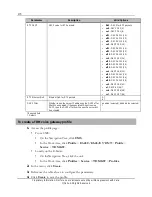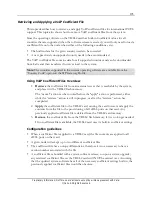
175
Proprietary Information: Not for use or disclosure except by written agreement with Calix.
© Calix. All Rights Reserved.
Retrieving and Applying a VoIP Coefficient File
This topic describes how to retrieve, and apply VoIP coefficient files for international POTS
support. This topic also shows how to remove VoIP coefficient files from the system.
Since the operating software on the VDSL2 card has built-in Coefficient values for all
countries that are supported when the software release is created, you will only need to load a
coefficient file onto the node when either of the following conditions exist:
The built-in data for the given country needs to be corrected
A new, previously unsupported country needs to be accommodated
The VoIP coefficient file contains data for all supported countries and can be downloaded
from Calix and then transferred to server local to the system.
Note:
The countries supported in the current operating software are available from the
“Country Code” option in the SIP Gateway Profile.
Using VoIP Coefficient Files Overview
1.
Retrieve
the coefficient file from an external server that is reachable by the system,
and place it in the VDSL2 flash memory.
The “cancel” action can be invoked before the "apply" action is performed, either
while the “retrieve” action is still in progress, or after the “retrieve” action has
completed.
2.
Apply
the coefficient file to the VDSL2 card, causing the card to reset and apply the
contents from the file to the provisioning of all xDSL ports on that card. Any
previously applied coefficient file is deleted from the VDSL2 card memory.
3.
Remove
the coefficient file from the VDSL2 flash memory, if it is no longer needed.
If no coefficient file is available, the VDSL2 card uses its built-in coefficient settings.
Configuration guidelines
When a coefficient file is applied to a VDSL2 card, the file contents are applied to all
xDSL ports on that card.
A given node will accept up to two different coefficient files.
The coefficient file has a unique differentiator, therefore it is not necessary to have a
version number associated with the file.
A coefficient file is bundled with a system software release, so upon a system upgrade,
any retrieved coefficient files on the VDSL2 cards will NOT be carried over. Assuming
that the updated system software has all of the necessary coefficient settings built-in, the
previously applied coefficient files would be obsolete.






























